Cadbury's Marketing Essentials: Analysis of Mix and Strategic Plan
VerifiedAdded on 2023/01/12
|8
|2404
|91
Report
AI Summary
This report provides an in-depth analysis of Cadbury's marketing essentials, focusing on key elements such as product management, marketing information, pricing, promotion, and selling, and their relationship with other functional units within the organization. It compares Cadbury's marketing mix, including product, price, place, promotion, people, process, and physical evidence, with its rival, Nestle. The report also evaluates Cadbury's strategic marketing plan, examining its vision, mission, objectives, target market, and various market strategies and tactics, such as increasing sales, maximizing profits, utilizing scarce resources, and building employee relations. The analysis concludes that effective marketing is crucial for understanding consumer demand, promoting products, and developing strategic decision-making to foster business growth and stability in the global market.

Marketing
Essentials
Essentials
Paraphrase This Document
Need a fresh take? Get an instant paraphrase of this document with our AI Paraphraser

Table of Contents
INTRODIUCTION....................................................................................................................3
ACTIVITY 1..............................................................................................................................3
Covered in PPT..........................................................................................................................3
ACTIVITY 2..............................................................................................................................3
CONCLUSION..........................................................................................................................6
REFERENCES...........................................................................................................................7
INTRODIUCTION....................................................................................................................3
ACTIVITY 1..............................................................................................................................3
Covered in PPT..........................................................................................................................3
ACTIVITY 2..............................................................................................................................3
CONCLUSION..........................................................................................................................6
REFERENCES...........................................................................................................................7
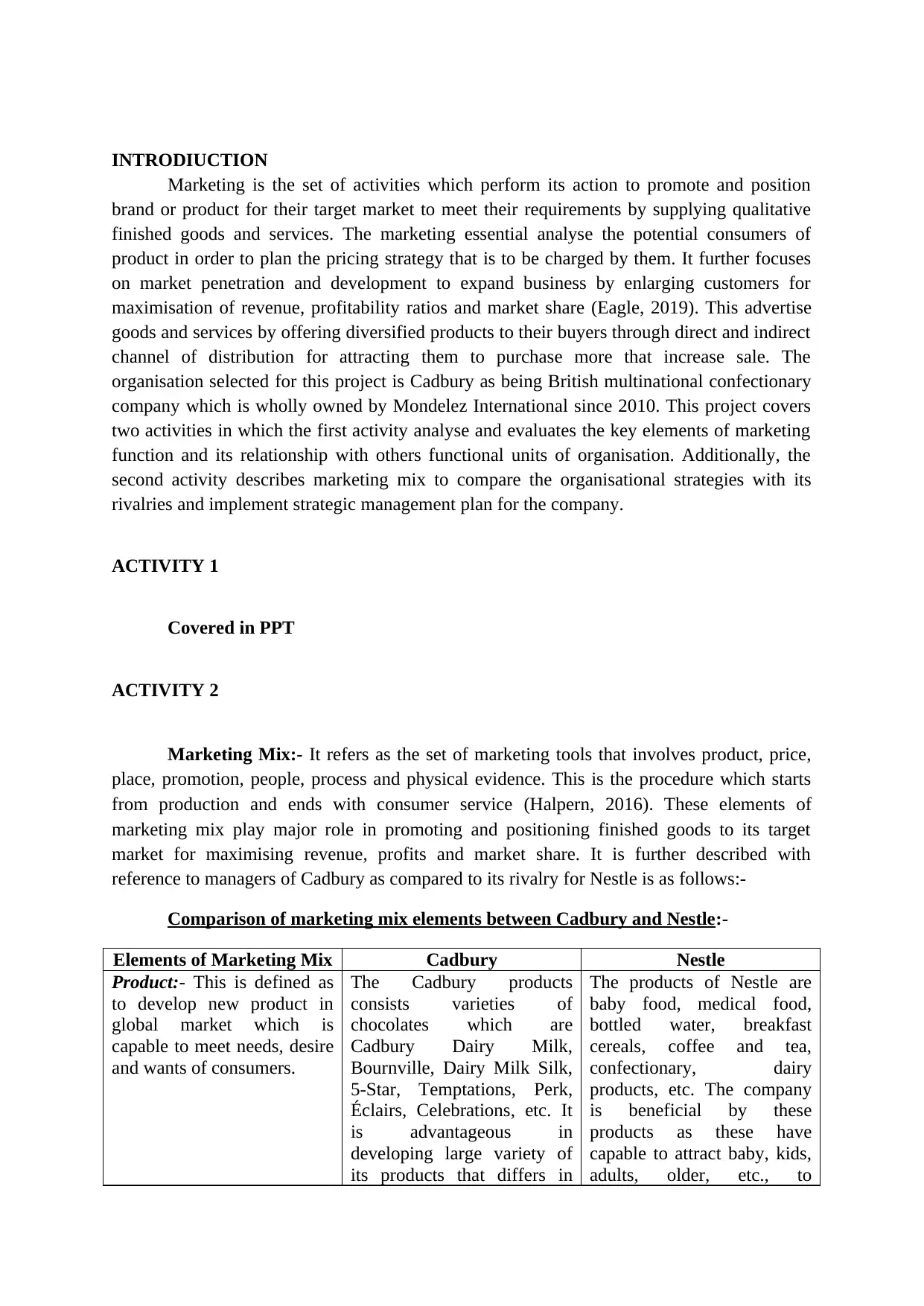
INTRODIUCTION
Marketing is the set of activities which perform its action to promote and position
brand or product for their target market to meet their requirements by supplying qualitative
finished goods and services. The marketing essential analyse the potential consumers of
product in order to plan the pricing strategy that is to be charged by them. It further focuses
on market penetration and development to expand business by enlarging customers for
maximisation of revenue, profitability ratios and market share (Eagle, 2019). This advertise
goods and services by offering diversified products to their buyers through direct and indirect
channel of distribution for attracting them to purchase more that increase sale. The
organisation selected for this project is Cadbury as being British multinational confectionary
company which is wholly owned by Mondelez International since 2010. This project covers
two activities in which the first activity analyse and evaluates the key elements of marketing
function and its relationship with others functional units of organisation. Additionally, the
second activity describes marketing mix to compare the organisational strategies with its
rivalries and implement strategic management plan for the company.
ACTIVITY 1
Covered in PPT
ACTIVITY 2
Marketing Mix:- It refers as the set of marketing tools that involves product, price,
place, promotion, people, process and physical evidence. This is the procedure which starts
from production and ends with consumer service (Halpern, 2016). These elements of
marketing mix play major role in promoting and positioning finished goods to its target
market for maximising revenue, profits and market share. It is further described with
reference to managers of Cadbury as compared to its rivalry for Nestle is as follows:-
Comparison of marketing mix elements between Cadbury and Nestle:-
Elements of Marketing Mix Cadbury Nestle
Product:- This is defined as
to develop new product in
global market which is
capable to meet needs, desire
and wants of consumers.
The Cadbury products
consists varieties of
chocolates which are
Cadbury Dairy Milk,
Bournville, Dairy Milk Silk,
5-Star, Temptations, Perk,
Éclairs, Celebrations, etc. It
is advantageous in
developing large variety of
its products that differs in
The products of Nestle are
baby food, medical food,
bottled water, breakfast
cereals, coffee and tea,
confectionary, dairy
products, etc. The company
is beneficial by these
products as these have
capable to attract baby, kids,
adults, older, etc., to
Marketing is the set of activities which perform its action to promote and position
brand or product for their target market to meet their requirements by supplying qualitative
finished goods and services. The marketing essential analyse the potential consumers of
product in order to plan the pricing strategy that is to be charged by them. It further focuses
on market penetration and development to expand business by enlarging customers for
maximisation of revenue, profitability ratios and market share (Eagle, 2019). This advertise
goods and services by offering diversified products to their buyers through direct and indirect
channel of distribution for attracting them to purchase more that increase sale. The
organisation selected for this project is Cadbury as being British multinational confectionary
company which is wholly owned by Mondelez International since 2010. This project covers
two activities in which the first activity analyse and evaluates the key elements of marketing
function and its relationship with others functional units of organisation. Additionally, the
second activity describes marketing mix to compare the organisational strategies with its
rivalries and implement strategic management plan for the company.
ACTIVITY 1
Covered in PPT
ACTIVITY 2
Marketing Mix:- It refers as the set of marketing tools that involves product, price,
place, promotion, people, process and physical evidence. This is the procedure which starts
from production and ends with consumer service (Halpern, 2016). These elements of
marketing mix play major role in promoting and positioning finished goods to its target
market for maximising revenue, profits and market share. It is further described with
reference to managers of Cadbury as compared to its rivalry for Nestle is as follows:-
Comparison of marketing mix elements between Cadbury and Nestle:-
Elements of Marketing Mix Cadbury Nestle
Product:- This is defined as
to develop new product in
global market which is
capable to meet needs, desire
and wants of consumers.
The Cadbury products
consists varieties of
chocolates which are
Cadbury Dairy Milk,
Bournville, Dairy Milk Silk,
5-Star, Temptations, Perk,
Éclairs, Celebrations, etc. It
is advantageous in
developing large variety of
its products that differs in
The products of Nestle are
baby food, medical food,
bottled water, breakfast
cereals, coffee and tea,
confectionary, dairy
products, etc. The company
is beneficial by these
products as these have
capable to attract baby, kids,
adults, older, etc., to
⊘ This is a preview!⊘
Do you want full access?
Subscribe today to unlock all pages.

Trusted by 1+ million students worldwide
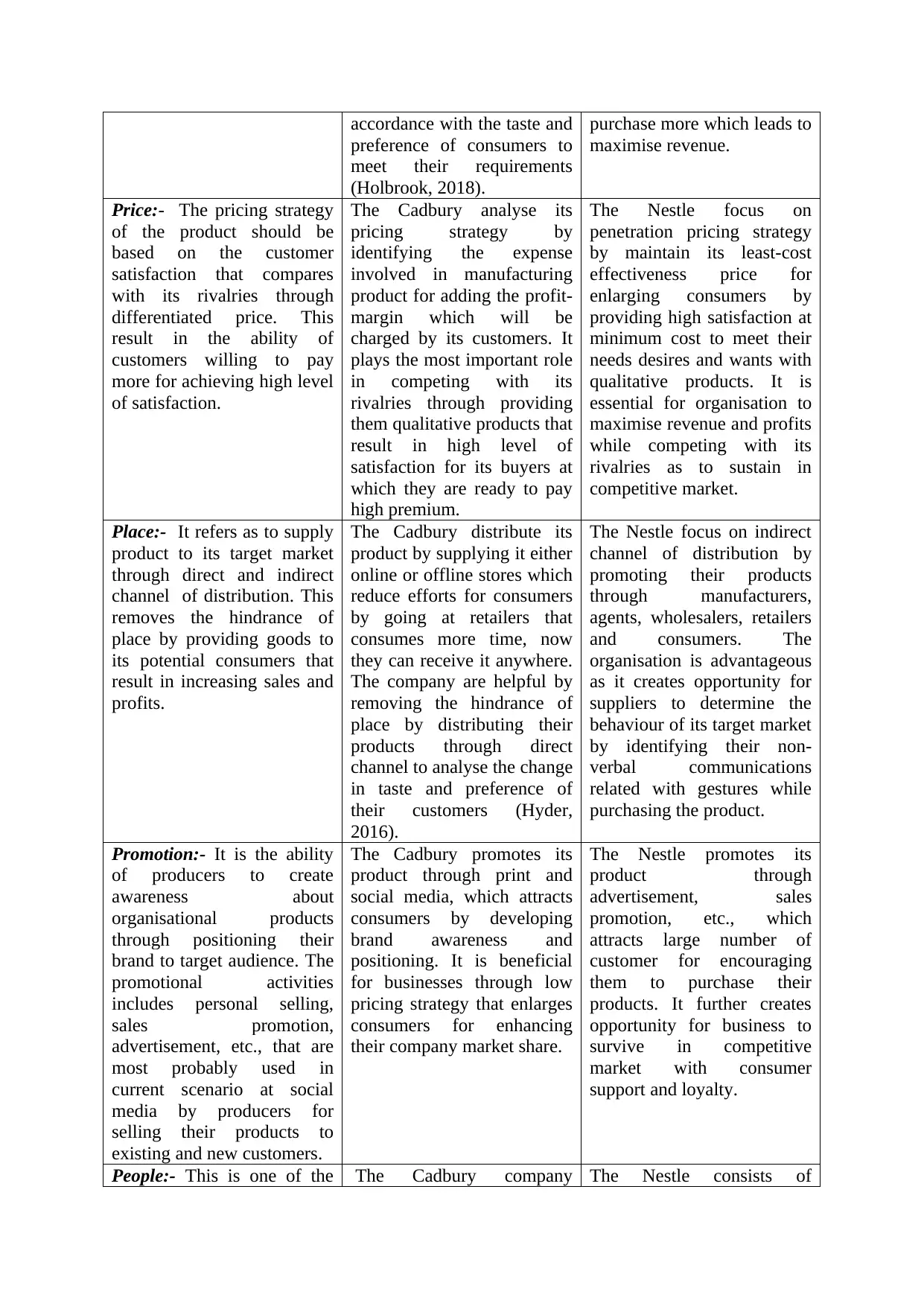
accordance with the taste and
preference of consumers to
meet their requirements
(Holbrook, 2018).
purchase more which leads to
maximise revenue.
Price:- The pricing strategy
of the product should be
based on the customer
satisfaction that compares
with its rivalries through
differentiated price. This
result in the ability of
customers willing to pay
more for achieving high level
of satisfaction.
The Cadbury analyse its
pricing strategy by
identifying the expense
involved in manufacturing
product for adding the profit-
margin which will be
charged by its customers. It
plays the most important role
in competing with its
rivalries through providing
them qualitative products that
result in high level of
satisfaction for its buyers at
which they are ready to pay
high premium.
The Nestle focus on
penetration pricing strategy
by maintain its least-cost
effectiveness price for
enlarging consumers by
providing high satisfaction at
minimum cost to meet their
needs desires and wants with
qualitative products. It is
essential for organisation to
maximise revenue and profits
while competing with its
rivalries as to sustain in
competitive market.
Place:- It refers as to supply
product to its target market
through direct and indirect
channel of distribution. This
removes the hindrance of
place by providing goods to
its potential consumers that
result in increasing sales and
profits.
The Cadbury distribute its
product by supplying it either
online or offline stores which
reduce efforts for consumers
by going at retailers that
consumes more time, now
they can receive it anywhere.
The company are helpful by
removing the hindrance of
place by distributing their
products through direct
channel to analyse the change
in taste and preference of
their customers (Hyder,
2016).
The Nestle focus on indirect
channel of distribution by
promoting their products
through manufacturers,
agents, wholesalers, retailers
and consumers. The
organisation is advantageous
as it creates opportunity for
suppliers to determine the
behaviour of its target market
by identifying their non-
verbal communications
related with gestures while
purchasing the product.
Promotion:- It is the ability
of producers to create
awareness about
organisational products
through positioning their
brand to target audience. The
promotional activities
includes personal selling,
sales promotion,
advertisement, etc., that are
most probably used in
current scenario at social
media by producers for
selling their products to
existing and new customers.
The Cadbury promotes its
product through print and
social media, which attracts
consumers by developing
brand awareness and
positioning. It is beneficial
for businesses through low
pricing strategy that enlarges
consumers for enhancing
their company market share.
The Nestle promotes its
product through
advertisement, sales
promotion, etc., which
attracts large number of
customer for encouraging
them to purchase their
products. It further creates
opportunity for business to
survive in competitive
market with consumer
support and loyalty.
People:- This is one of the The Cadbury company The Nestle consists of
preference of consumers to
meet their requirements
(Holbrook, 2018).
purchase more which leads to
maximise revenue.
Price:- The pricing strategy
of the product should be
based on the customer
satisfaction that compares
with its rivalries through
differentiated price. This
result in the ability of
customers willing to pay
more for achieving high level
of satisfaction.
The Cadbury analyse its
pricing strategy by
identifying the expense
involved in manufacturing
product for adding the profit-
margin which will be
charged by its customers. It
plays the most important role
in competing with its
rivalries through providing
them qualitative products that
result in high level of
satisfaction for its buyers at
which they are ready to pay
high premium.
The Nestle focus on
penetration pricing strategy
by maintain its least-cost
effectiveness price for
enlarging consumers by
providing high satisfaction at
minimum cost to meet their
needs desires and wants with
qualitative products. It is
essential for organisation to
maximise revenue and profits
while competing with its
rivalries as to sustain in
competitive market.
Place:- It refers as to supply
product to its target market
through direct and indirect
channel of distribution. This
removes the hindrance of
place by providing goods to
its potential consumers that
result in increasing sales and
profits.
The Cadbury distribute its
product by supplying it either
online or offline stores which
reduce efforts for consumers
by going at retailers that
consumes more time, now
they can receive it anywhere.
The company are helpful by
removing the hindrance of
place by distributing their
products through direct
channel to analyse the change
in taste and preference of
their customers (Hyder,
2016).
The Nestle focus on indirect
channel of distribution by
promoting their products
through manufacturers,
agents, wholesalers, retailers
and consumers. The
organisation is advantageous
as it creates opportunity for
suppliers to determine the
behaviour of its target market
by identifying their non-
verbal communications
related with gestures while
purchasing the product.
Promotion:- It is the ability
of producers to create
awareness about
organisational products
through positioning their
brand to target audience. The
promotional activities
includes personal selling,
sales promotion,
advertisement, etc., that are
most probably used in
current scenario at social
media by producers for
selling their products to
existing and new customers.
The Cadbury promotes its
product through print and
social media, which attracts
consumers by developing
brand awareness and
positioning. It is beneficial
for businesses through low
pricing strategy that enlarges
consumers for enhancing
their company market share.
The Nestle promotes its
product through
advertisement, sales
promotion, etc., which
attracts large number of
customer for encouraging
them to purchase their
products. It further creates
opportunity for business to
survive in competitive
market with consumer
support and loyalty.
People:- This is one of the The Cadbury company The Nestle consists of
Paraphrase This Document
Need a fresh take? Get an instant paraphrase of this document with our AI Paraphraser
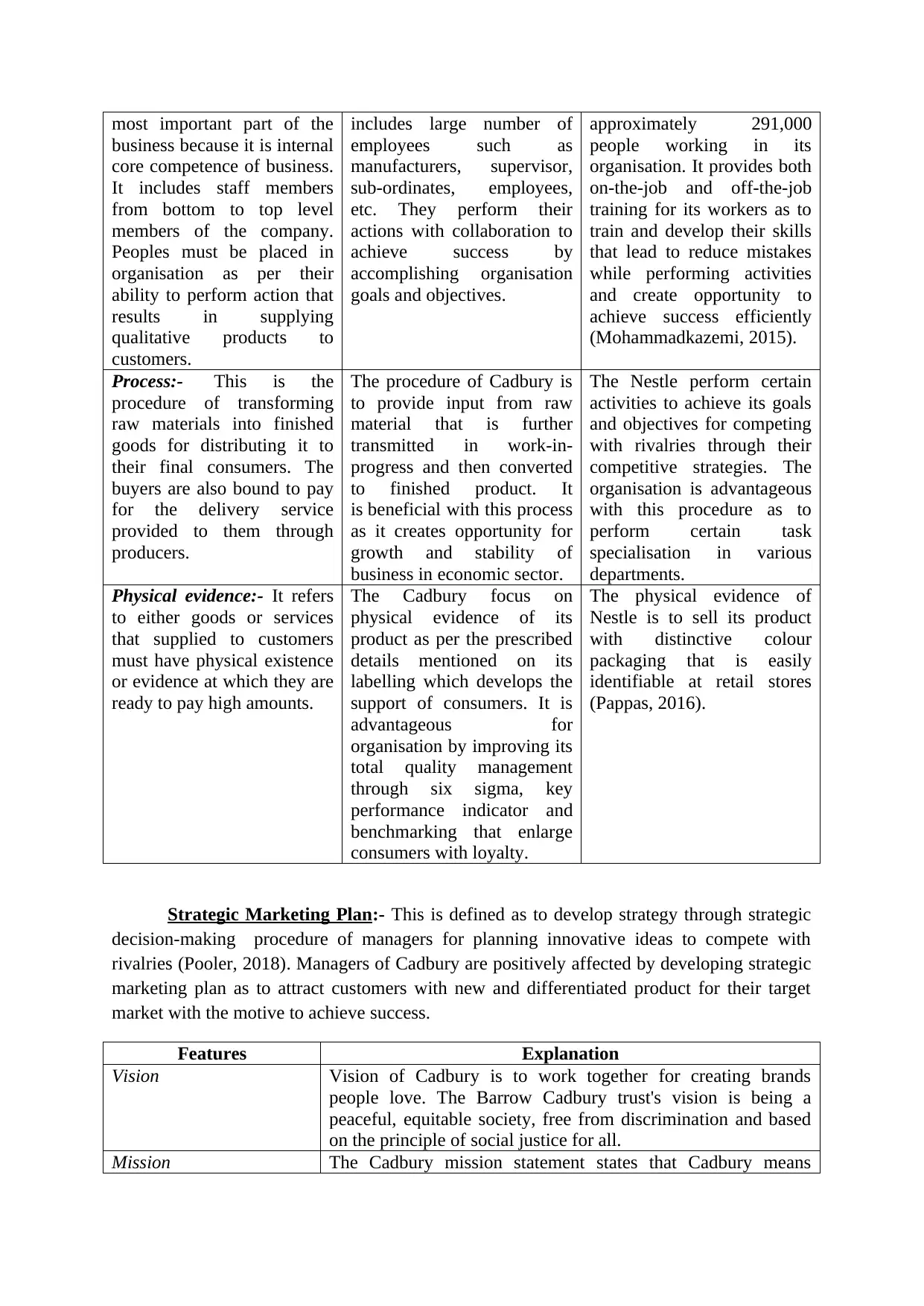
most important part of the
business because it is internal
core competence of business.
It includes staff members
from bottom to top level
members of the company.
Peoples must be placed in
organisation as per their
ability to perform action that
results in supplying
qualitative products to
customers.
includes large number of
employees such as
manufacturers, supervisor,
sub-ordinates, employees,
etc. They perform their
actions with collaboration to
achieve success by
accomplishing organisation
goals and objectives.
approximately 291,000
people working in its
organisation. It provides both
on-the-job and off-the-job
training for its workers as to
train and develop their skills
that lead to reduce mistakes
while performing activities
and create opportunity to
achieve success efficiently
(Mohammadkazemi, 2015).
Process:- This is the
procedure of transforming
raw materials into finished
goods for distributing it to
their final consumers. The
buyers are also bound to pay
for the delivery service
provided to them through
producers.
The procedure of Cadbury is
to provide input from raw
material that is further
transmitted in work-in-
progress and then converted
to finished product. It
is beneficial with this process
as it creates opportunity for
growth and stability of
business in economic sector.
The Nestle perform certain
activities to achieve its goals
and objectives for competing
with rivalries through their
competitive strategies. The
organisation is advantageous
with this procedure as to
perform certain task
specialisation in various
departments.
Physical evidence:- It refers
to either goods or services
that supplied to customers
must have physical existence
or evidence at which they are
ready to pay high amounts.
The Cadbury focus on
physical evidence of its
product as per the prescribed
details mentioned on its
labelling which develops the
support of consumers. It is
advantageous for
organisation by improving its
total quality management
through six sigma, key
performance indicator and
benchmarking that enlarge
consumers with loyalty.
The physical evidence of
Nestle is to sell its product
with distinctive colour
packaging that is easily
identifiable at retail stores
(Pappas, 2016).
Strategic Marketing Plan:- This is defined as to develop strategy through strategic
decision-making procedure of managers for planning innovative ideas to compete with
rivalries (Pooler, 2018). Managers of Cadbury are positively affected by developing strategic
marketing plan as to attract customers with new and differentiated product for their target
market with the motive to achieve success.
Features Explanation
Vision Vision of Cadbury is to work together for creating brands
people love. The Barrow Cadbury trust's vision is being a
peaceful, equitable society, free from discrimination and based
on the principle of social justice for all.
Mission The Cadbury mission statement states that Cadbury means
business because it is internal
core competence of business.
It includes staff members
from bottom to top level
members of the company.
Peoples must be placed in
organisation as per their
ability to perform action that
results in supplying
qualitative products to
customers.
includes large number of
employees such as
manufacturers, supervisor,
sub-ordinates, employees,
etc. They perform their
actions with collaboration to
achieve success by
accomplishing organisation
goals and objectives.
approximately 291,000
people working in its
organisation. It provides both
on-the-job and off-the-job
training for its workers as to
train and develop their skills
that lead to reduce mistakes
while performing activities
and create opportunity to
achieve success efficiently
(Mohammadkazemi, 2015).
Process:- This is the
procedure of transforming
raw materials into finished
goods for distributing it to
their final consumers. The
buyers are also bound to pay
for the delivery service
provided to them through
producers.
The procedure of Cadbury is
to provide input from raw
material that is further
transmitted in work-in-
progress and then converted
to finished product. It
is beneficial with this process
as it creates opportunity for
growth and stability of
business in economic sector.
The Nestle perform certain
activities to achieve its goals
and objectives for competing
with rivalries through their
competitive strategies. The
organisation is advantageous
with this procedure as to
perform certain task
specialisation in various
departments.
Physical evidence:- It refers
to either goods or services
that supplied to customers
must have physical existence
or evidence at which they are
ready to pay high amounts.
The Cadbury focus on
physical evidence of its
product as per the prescribed
details mentioned on its
labelling which develops the
support of consumers. It is
advantageous for
organisation by improving its
total quality management
through six sigma, key
performance indicator and
benchmarking that enlarge
consumers with loyalty.
The physical evidence of
Nestle is to sell its product
with distinctive colour
packaging that is easily
identifiable at retail stores
(Pappas, 2016).
Strategic Marketing Plan:- This is defined as to develop strategy through strategic
decision-making procedure of managers for planning innovative ideas to compete with
rivalries (Pooler, 2018). Managers of Cadbury are positively affected by developing strategic
marketing plan as to attract customers with new and differentiated product for their target
market with the motive to achieve success.
Features Explanation
Vision Vision of Cadbury is to work together for creating brands
people love. The Barrow Cadbury trust's vision is being a
peaceful, equitable society, free from discrimination and based
on the principle of social justice for all.
Mission The Cadbury mission statement states that Cadbury means
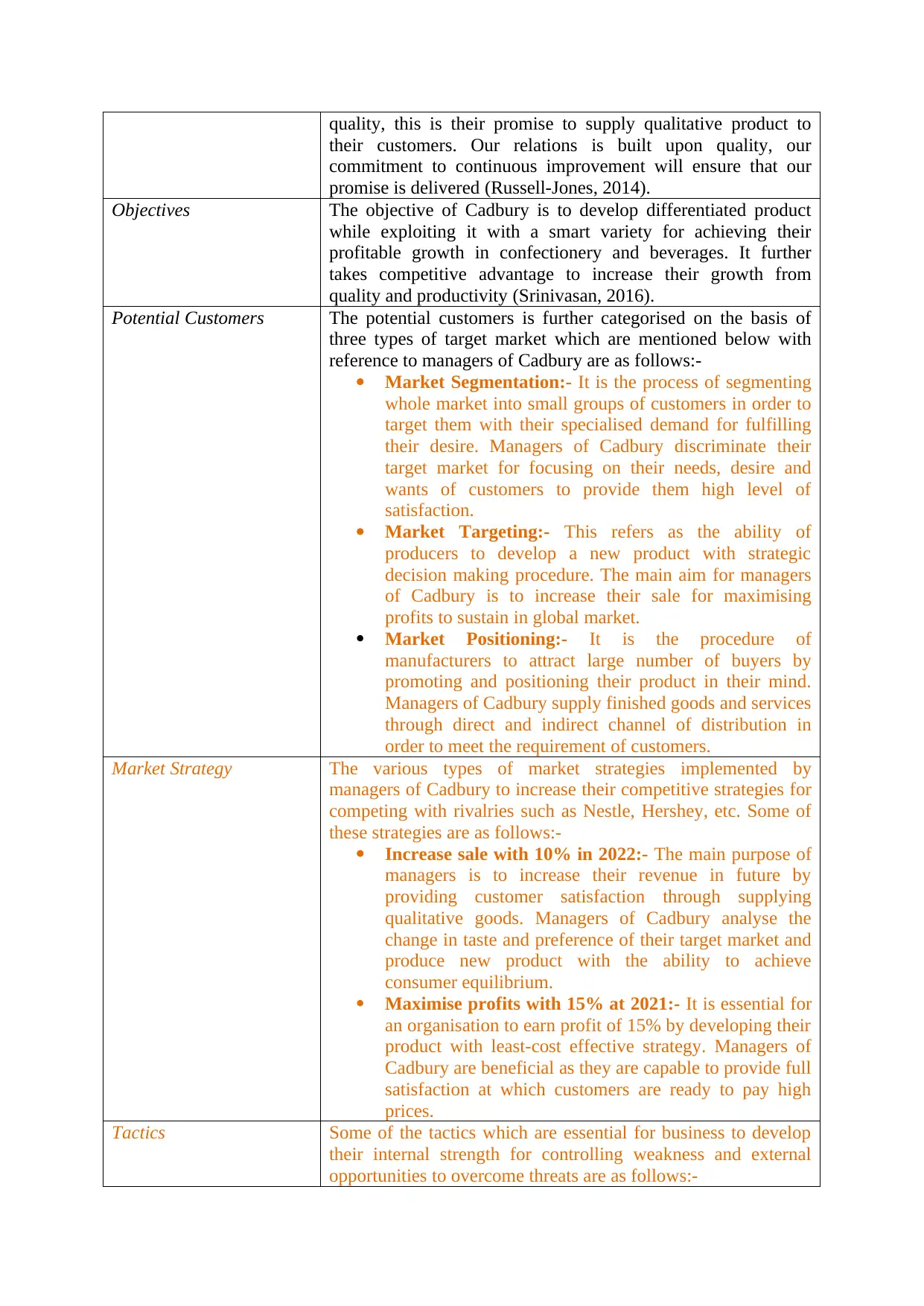
quality, this is their promise to supply qualitative product to
their customers. Our relations is built upon quality, our
commitment to continuous improvement will ensure that our
promise is delivered (Russell-Jones, 2014).
Objectives The objective of Cadbury is to develop differentiated product
while exploiting it with a smart variety for achieving their
profitable growth in confectionery and beverages. It further
takes competitive advantage to increase their growth from
quality and productivity (Srinivasan, 2016).
Potential Customers The potential customers is further categorised on the basis of
three types of target market which are mentioned below with
reference to managers of Cadbury are as follows:-
Market Segmentation:- It is the process of segmenting
whole market into small groups of customers in order to
target them with their specialised demand for fulfilling
their desire. Managers of Cadbury discriminate their
target market for focusing on their needs, desire and
wants of customers to provide them high level of
satisfaction.
Market Targeting:- This refers as the ability of
producers to develop a new product with strategic
decision making procedure. The main aim for managers
of Cadbury is to increase their sale for maximising
profits to sustain in global market.
Market Positioning:- It is the procedure of
manufacturers to attract large number of buyers by
promoting and positioning their product in their mind.
Managers of Cadbury supply finished goods and services
through direct and indirect channel of distribution in
order to meet the requirement of customers.
Market Strategy The various types of market strategies implemented by
managers of Cadbury to increase their competitive strategies for
competing with rivalries such as Nestle, Hershey, etc. Some of
these strategies are as follows:-
Increase sale with 10% in 2022:- The main purpose of
managers is to increase their revenue in future by
providing customer satisfaction through supplying
qualitative goods. Managers of Cadbury analyse the
change in taste and preference of their target market and
produce new product with the ability to achieve
consumer equilibrium.
Maximise profits with 15% at 2021:- It is essential for
an organisation to earn profit of 15% by developing their
product with least-cost effective strategy. Managers of
Cadbury are beneficial as they are capable to provide full
satisfaction at which customers are ready to pay high
prices.
Tactics Some of the tactics which are essential for business to develop
their internal strength for controlling weakness and external
opportunities to overcome threats are as follows:-
their customers. Our relations is built upon quality, our
commitment to continuous improvement will ensure that our
promise is delivered (Russell-Jones, 2014).
Objectives The objective of Cadbury is to develop differentiated product
while exploiting it with a smart variety for achieving their
profitable growth in confectionery and beverages. It further
takes competitive advantage to increase their growth from
quality and productivity (Srinivasan, 2016).
Potential Customers The potential customers is further categorised on the basis of
three types of target market which are mentioned below with
reference to managers of Cadbury are as follows:-
Market Segmentation:- It is the process of segmenting
whole market into small groups of customers in order to
target them with their specialised demand for fulfilling
their desire. Managers of Cadbury discriminate their
target market for focusing on their needs, desire and
wants of customers to provide them high level of
satisfaction.
Market Targeting:- This refers as the ability of
producers to develop a new product with strategic
decision making procedure. The main aim for managers
of Cadbury is to increase their sale for maximising
profits to sustain in global market.
Market Positioning:- It is the procedure of
manufacturers to attract large number of buyers by
promoting and positioning their product in their mind.
Managers of Cadbury supply finished goods and services
through direct and indirect channel of distribution in
order to meet the requirement of customers.
Market Strategy The various types of market strategies implemented by
managers of Cadbury to increase their competitive strategies for
competing with rivalries such as Nestle, Hershey, etc. Some of
these strategies are as follows:-
Increase sale with 10% in 2022:- The main purpose of
managers is to increase their revenue in future by
providing customer satisfaction through supplying
qualitative goods. Managers of Cadbury analyse the
change in taste and preference of their target market and
produce new product with the ability to achieve
consumer equilibrium.
Maximise profits with 15% at 2021:- It is essential for
an organisation to earn profit of 15% by developing their
product with least-cost effective strategy. Managers of
Cadbury are beneficial as they are capable to provide full
satisfaction at which customers are ready to pay high
prices.
Tactics Some of the tactics which are essential for business to develop
their internal strength for controlling weakness and external
opportunities to overcome threats are as follows:-
⊘ This is a preview!⊘
Do you want full access?
Subscribe today to unlock all pages.

Trusted by 1+ million students worldwide
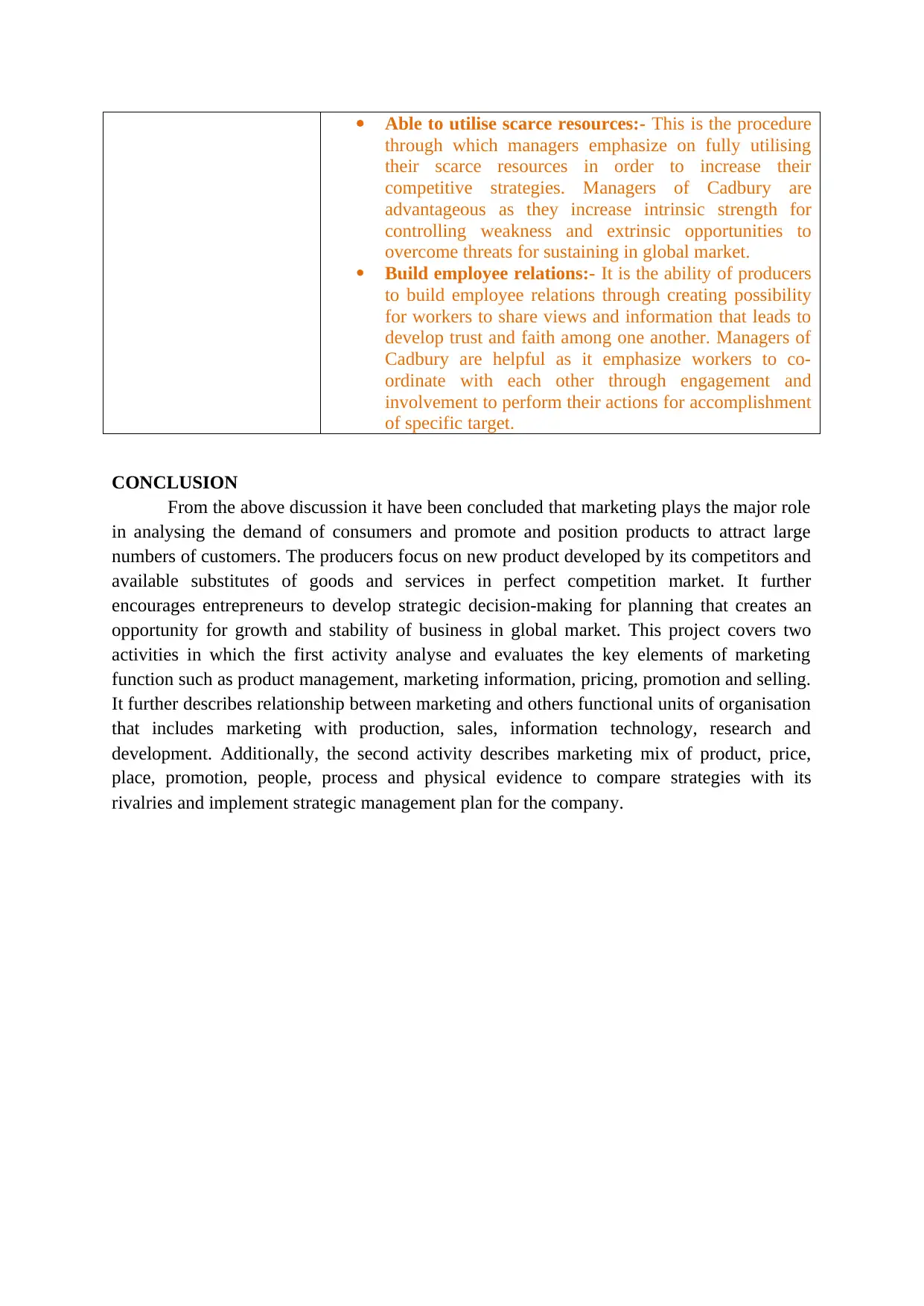
Able to utilise scarce resources:- This is the procedure
through which managers emphasize on fully utilising
their scarce resources in order to increase their
competitive strategies. Managers of Cadbury are
advantageous as they increase intrinsic strength for
controlling weakness and extrinsic opportunities to
overcome threats for sustaining in global market.
Build employee relations:- It is the ability of producers
to build employee relations through creating possibility
for workers to share views and information that leads to
develop trust and faith among one another. Managers of
Cadbury are helpful as it emphasize workers to co-
ordinate with each other through engagement and
involvement to perform their actions for accomplishment
of specific target.
CONCLUSION
From the above discussion it have been concluded that marketing plays the major role
in analysing the demand of consumers and promote and position products to attract large
numbers of customers. The producers focus on new product developed by its competitors and
available substitutes of goods and services in perfect competition market. It further
encourages entrepreneurs to develop strategic decision-making for planning that creates an
opportunity for growth and stability of business in global market. This project covers two
activities in which the first activity analyse and evaluates the key elements of marketing
function such as product management, marketing information, pricing, promotion and selling.
It further describes relationship between marketing and others functional units of organisation
that includes marketing with production, sales, information technology, research and
development. Additionally, the second activity describes marketing mix of product, price,
place, promotion, people, process and physical evidence to compare strategies with its
rivalries and implement strategic management plan for the company.
through which managers emphasize on fully utilising
their scarce resources in order to increase their
competitive strategies. Managers of Cadbury are
advantageous as they increase intrinsic strength for
controlling weakness and extrinsic opportunities to
overcome threats for sustaining in global market.
Build employee relations:- It is the ability of producers
to build employee relations through creating possibility
for workers to share views and information that leads to
develop trust and faith among one another. Managers of
Cadbury are helpful as it emphasize workers to co-
ordinate with each other through engagement and
involvement to perform their actions for accomplishment
of specific target.
CONCLUSION
From the above discussion it have been concluded that marketing plays the major role
in analysing the demand of consumers and promote and position products to attract large
numbers of customers. The producers focus on new product developed by its competitors and
available substitutes of goods and services in perfect competition market. It further
encourages entrepreneurs to develop strategic decision-making for planning that creates an
opportunity for growth and stability of business in global market. This project covers two
activities in which the first activity analyse and evaluates the key elements of marketing
function such as product management, marketing information, pricing, promotion and selling.
It further describes relationship between marketing and others functional units of organisation
that includes marketing with production, sales, information technology, research and
development. Additionally, the second activity describes marketing mix of product, price,
place, promotion, people, process and physical evidence to compare strategies with its
rivalries and implement strategic management plan for the company.
Paraphrase This Document
Need a fresh take? Get an instant paraphrase of this document with our AI Paraphraser
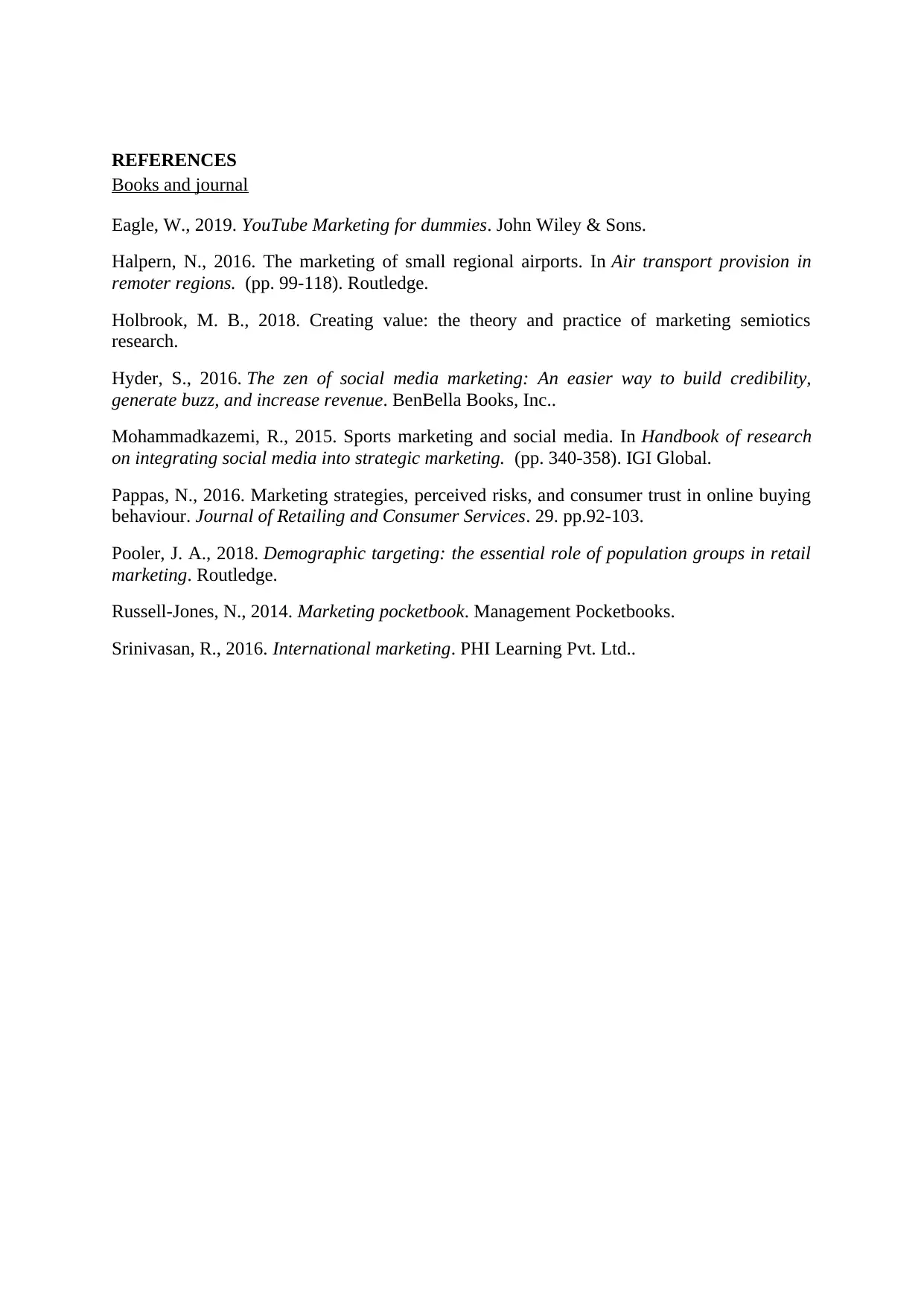
REFERENCES
Books and journal
Eagle, W., 2019. YouTube Marketing for dummies. John Wiley & Sons.
Halpern, N., 2016. The marketing of small regional airports. In Air transport provision in
remoter regions. (pp. 99-118). Routledge.
Holbrook, M. B., 2018. Creating value: the theory and practice of marketing semiotics
research.
Hyder, S., 2016. The zen of social media marketing: An easier way to build credibility,
generate buzz, and increase revenue. BenBella Books, Inc..
Mohammadkazemi, R., 2015. Sports marketing and social media. In Handbook of research
on integrating social media into strategic marketing. (pp. 340-358). IGI Global.
Pappas, N., 2016. Marketing strategies, perceived risks, and consumer trust in online buying
behaviour. Journal of Retailing and Consumer Services. 29. pp.92-103.
Pooler, J. A., 2018. Demographic targeting: the essential role of population groups in retail
marketing. Routledge.
Russell-Jones, N., 2014. Marketing pocketbook. Management Pocketbooks.
Srinivasan, R., 2016. International marketing. PHI Learning Pvt. Ltd..
Books and journal
Eagle, W., 2019. YouTube Marketing for dummies. John Wiley & Sons.
Halpern, N., 2016. The marketing of small regional airports. In Air transport provision in
remoter regions. (pp. 99-118). Routledge.
Holbrook, M. B., 2018. Creating value: the theory and practice of marketing semiotics
research.
Hyder, S., 2016. The zen of social media marketing: An easier way to build credibility,
generate buzz, and increase revenue. BenBella Books, Inc..
Mohammadkazemi, R., 2015. Sports marketing and social media. In Handbook of research
on integrating social media into strategic marketing. (pp. 340-358). IGI Global.
Pappas, N., 2016. Marketing strategies, perceived risks, and consumer trust in online buying
behaviour. Journal of Retailing and Consumer Services. 29. pp.92-103.
Pooler, J. A., 2018. Demographic targeting: the essential role of population groups in retail
marketing. Routledge.
Russell-Jones, N., 2014. Marketing pocketbook. Management Pocketbooks.
Srinivasan, R., 2016. International marketing. PHI Learning Pvt. Ltd..
1 out of 8
Related Documents
Your All-in-One AI-Powered Toolkit for Academic Success.
+13062052269
info@desklib.com
Available 24*7 on WhatsApp / Email
![[object Object]](/_next/static/media/star-bottom.7253800d.svg)
Unlock your academic potential
Copyright © 2020–2025 A2Z Services. All Rights Reserved. Developed and managed by ZUCOL.




